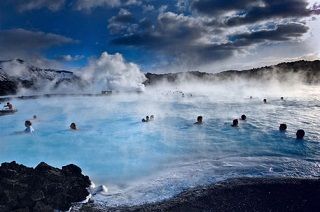Outlook for Geothermal

The concept behind Raser was compressing the timescale required to get a geothermal plant operational by doing the drilling and the plant construction at the same time. I’m sure someone must have asked, “But since geothermal drilling is inherently risky (far riskier than oil/gas drilling), doesn’t this strategy effectively accentuate our risks significantly? Isn’t this like going to a race track, and, instead of betting $10 on the #4 horse to win in every race, deciding that we’re going to bet $100?”
In any case, my colleague asked what I thought about geothermal generally, and I explained:
First of all, it’s a slam dunk that has tons of obvious resources—especially if they have few other renewable options (e.g., Iceland–pictured above–never been there–doesn’t look too terrible), and
in all other cases, some really heavy-duty technology breakthroughs need to happen to make it competitive with wind and solar, given how these last two have scaled over the past few years and the prices have plummeted correspondingly. Obviously, geothermal is constant (vs. variable) in terms of its output, and therefore can function as baseload, but that’s not as big a deal as it used to be, and becoming less so as time goes on.

Craig,
Something to consider with regards to geothermal is the crash in oil prices.
The horizontal drilling rigs used for fracking are equally useful for drilling out an inlet well for enhanced geothermal energy, and of course a traditional horizontal drilling rig would suffice for the recovery well.
The US only has ~2000 rigs total. When oil was expensive, there was extremely high demand for those rigs, and the rent rates were insane (millions or even tens of millions of dollars a day). Now, however, only ~1000 rigs are in operation, leaving plenty of rigs laying idle, and rent rates are dropping dramatically. This will serve to cause the price of EGS to plummet – at least until oil prices rebound and spike next year – so there’s a window of time when an investor who wants to develop a shallow heat well can do so at a much lower cost.
I would be somewhat surprised – and disappointed – if at least a few players don’t step up and take a shot…
But with geothermal the cost is non-linear as the depth increases. 2-3 km deep is relatively cheap, while 5 km is extremely expensive. If one were to couple the two – so that a dual-sourced heat engine were to use a low-quality energy source (such as that found in a 3 km shallow well) to boil an organic fluid through phase change, then a mid-grade energy source (such as that found in a 5 km deep well) to super-heat the vapor… you could use the low-cost low-grade energy for a significant portion of the heating, and reserve the expensive source for the superheating – but yield the efficiency gain from the higher heat for the whole process.
I did some back-of-the-napkin work on what such a system would cost using our patented DORC (Dual-sourced-Organic Rankine Cycle), back when the rigs were prohibitively expensive, and the LCOE still worked out to ~$60-$90/MWh. Now… Who knows? (No time to chase down current drilling prices). It seems like it should be well worth taking a gamble on.